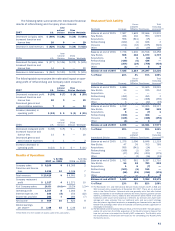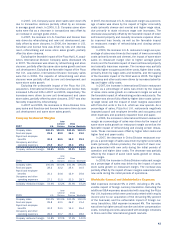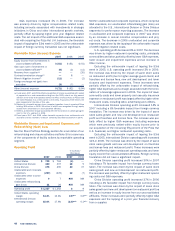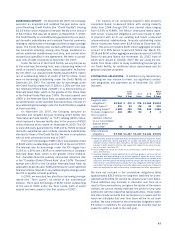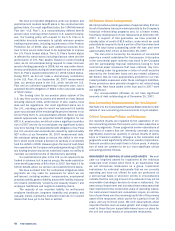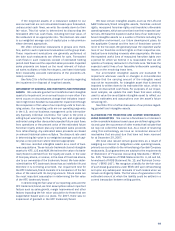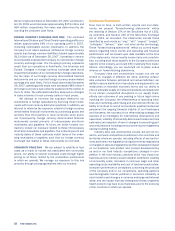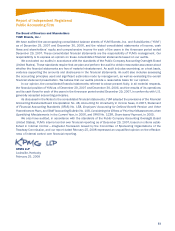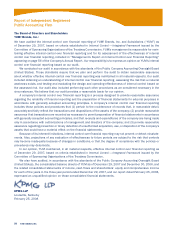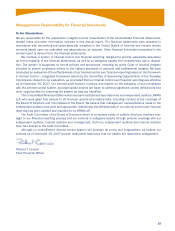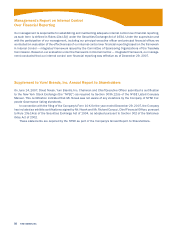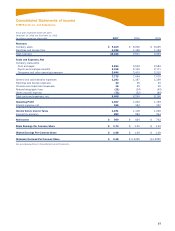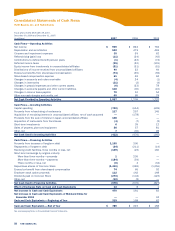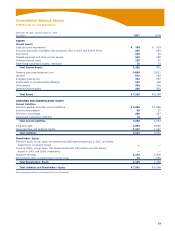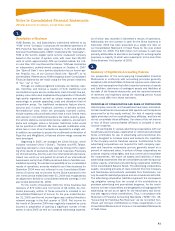Pizza Hut 2007 Annual Report Download - page 47
Download and view the complete annual report
Please find page 47 of the 2007 Pizza Hut annual report below. You can navigate through the pages in the report by either clicking on the pages listed below, or by using the keyword search tool below to find specific information within the annual report.51
STOCK OPTIONS AND STOCK APPRECIATION RIGHTS EXPENSE
Compensation expense for stock options and stock apprecia-
tion rights (“SARs”) is estimated on the grant date using a
Black-Scholes option pricing model. Our specific weighted-
average assumptions for the risk-free interest rate, expected
term, expected volatility and expected dividend yield are docu-
mented in Note 17. Additionally, under SFAS No. 123 (revised
2004), “Share-Based Compensation” (“SFAS 123R”) we are
required to estimate pre-vesting forfeitures for purposes of
determining compensation expense to be recognized. Future
expense amounts for any particular quarterly or annual period
could be affected by changes in our assumptions or changes
in market conditions.
We have determined that it is appropriate to group
our awards into two homogeneous groups when estimating
expected term and pre-vesting forfeitures. These groups con-
sist of grants made primarily to restaurant-level employees
under our Restaurant General Manager Stock Option Plan (the
“RGM Plan”) and grants made to executives under our other
stock award plans. Historically, approximately 15% –20% of
total options and SARs granted have been made under the
RGM Plan.
Grants under the RGM Plan typically cliff vest after four
years and grants made to executives under our other stock
award plans typically have a graded vesting schedule and
vest 25% per year over four years. We use a single weighted-
average expected term for our awards that have a graded
vesting schedule as permitted by SFAS 123R. We revaluate
our expected term assumptions using historical exercise and
post-vesting employment termination behavior on a regular
basis. Based on the results of this analysis, we have deter-
mined that six years is an appropriate expected term for awards
to both restaurant level employees and to executives.
Upon each stock award grant we revaluate the expected
volatility, including consideration of both historical volatility
of our stock as well as implied volatility associated with our
traded options. We have estimated forfeitures based on histor-
ical data. Based on such data, we believe that approximately
45% of all awards granted under the RGM Plan will be forfeited
and approximately 20% of all awards granted to above-store
executives will be forfeited.
INCOME TAX VALUATION ALLOWANCES AND UNRECOGNIZED
TAX BENEFITS At December 29, 2007, we had a valuation
allowance of $308 million primarily to reduce our net operat-
ing loss and tax credit carryforward benefits of $363 million,
as well as our other deferred tax assets, to amounts that
will more likely than not be realized. The net operating loss
and tax credit carryforwards exist in federal, state and for-
eign jurisdictions and have varying carryforward periods and
restrictions on usage. The estimation of future taxable income
in these jurisdictions and our resulting ability to utilize net
operating loss and tax credit carryforwards can significantly
change based on future events, including our determinations
as to the feasibility of certain tax planning strategies. Thus,
recorded valuation allowances may be subject to material
future changes.
As a matter of course, we are regularly audited by fed-
eral, state and foreign tax authorities. Effective December 31,
2006, we adopted Financial Accounting Standards Board
(“FASB”) Interpretation No. 48, “Accounting for Uncertainty
in Income Taxes” (“FIN 48”), an interpretation of Statement
of Financial Accounting Standards No. 109, “Accounting
for Income Taxes”. FIN 48 requires that a position taken or
expected to be taken in a tax return be recognized in the
financial statements when it is more likely than not (i.e. a
likelihood of more than fifty percent) that the position would
be sustained upon examination by tax authorities. A recog-
nized tax position is then measured at the largest amount of
benefit that is greater than fifty percent likely of being realized
upon settlement. At December 29, 2007, we had $376 mil-
lion of unrecognized tax benefits, $194 million of which, if
recognized, would affect the effective tax rate. We evaluate
unrecognized tax benefits, including interest thereon, on a
quarterly basis to insure that they have been appropriately
adjusted for events, including audit settlements, which may
impact our ultimate payment for such exposures.
See Note 20 for a further discussion of our income
taxes.
Quantitative and Qualitative Disclosures About
Market Risk
The Company is exposed to financial market risks associ-
ated with interest rates, foreign currency exchange rates and
commodity prices. In the normal course of business and in
accordance with our policies, we manage these risks through
a variety of strategies, which may include the use of derivative
financial and commodity instruments to hedge our underlying
exposures. Our policies prohibit the use of derivative instru-
ments for trading purposes, and we have procedures in place
to monitor and control their use.
INTEREST RATE RISK We have a market risk exposure to
changes in interest rates, principally in the U.S. We attempt
to minimize this risk and lower our overall borrowing costs
through the utilization of derivative financial instruments, pri-
marily interest rate swaps. These swaps are entered into with
financial institutions and have reset dates and critical terms
that match those of the underlying debt. Accordingly, any
change in market value associated with interest rate swaps
is offset by the opposite market impact on the related debt.
At December 29, 2007 and December 30, 2006, a
hypothetical 100 basis point increase in short-term interest
rates would result, over the following twelve-month period,
in a reduction of approximately $3 million and $9 million,
respectively, in income before income taxes. The estimated
reductions are based upon the level of variable rate debt
and assume no changes in the volume or composition of
that debt and include no impact from interest income related
to cash and cash equivalents. In addition, the fair value of
our derivative financial instruments at December 29, 2007
and December 30, 2006 would decrease approximately
$31 million and $32 million, respectively. The fair value of our


